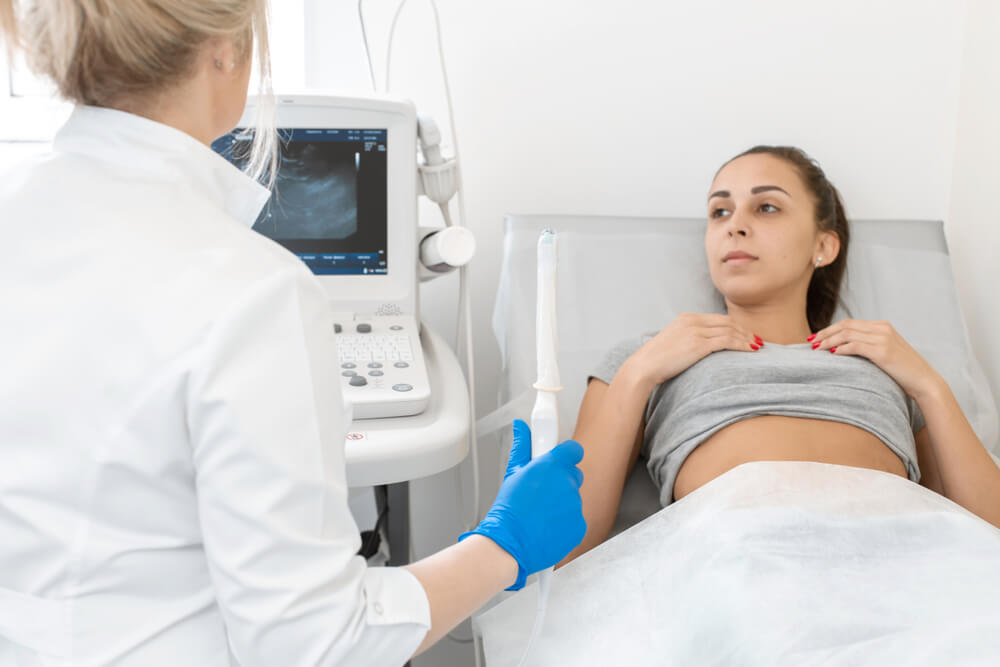A transvaginal ultrasound can make you feel nervous and uncomfortable, especially if you are undergoing the procedure for the first time.
While this diagnostic procedure may seem intimidating, proper preparation is key to maximizing its effectiveness and minimizing any potential discomfort.
If you’ve been scheduled for this procedure, it’s natural to have questions and concerns. This guide will walk you through the essential steps on how to prepare for a transvaginal ultrasound.
What Is a Transvaginal Ultrasound?
A transvaginal ultrasound is a non-invasive diagnostic procedure commonly used to examine the female reproductive organs. It involves using a small transducer probe gently inserted into the vagina. This allows for a close-up and detailed view of the uterus, ovaries, and surrounding tissues.
Transvaginal ultrasounds are safe, effective, and often recommended by healthcare professionals to investigate various gynecological conditions and concerns.

How Does A Transvaginal Ultrasound Work?
During a transvaginal ultrasound, the transducer emits high-frequency sound waves that travel through the vaginal walls and bounce back from the organs being examined.
These echoes are then converted into real-time images by a computer, which is displayed on a monitor. The procedure is typically painless, although you may feel some pressure or slight discomfort as the transducer is inserted.
The ultrasound technician will skillfully maneuver the transducer to capture the necessary images and gather valuable information about your reproductive health.
When Is This Procedure Performed?
Transvaginal ultrasounds are performed for various reasons. They can also be employed to monitor the growth and development of the fetus during pregnancy or to investigate fertility concerns.
- Gynecological evaluations: Allows healthcare providers to assess the health of the uterus, ovaries, and surrounding structures, providing valuable information for overall reproductive health.
- Pregnancy monitoring: Monitors the growth and development of the fetus. They help determine the gestational age, check for abnormalities, and assess the baby’s well-being.
- Evaluating fertility concerns: Helps assess the ovarian reserve, detect abnormalities, and monitor the reproductive organs to aid in fertility evaluations.
- Screening for gynecological conditions: Detests conditions like ovarian or uterine tumors, polyps, or structural abnormalities. They are crucial in early detection, allowing for timely intervention and treatment.
- Follow-up assessments: Monitors the healing process, assess the effectiveness of the treatment, or ensure the absence of complications.
Who Performs A Transvaginal Ultrasound?
A transvaginal ultrasound is typically performed by a trained healthcare professional called an ultrasound technician or sonographer.
These professionals specialize in using ultrasound technology to obtain images and gather diagnostic information. They have expertise in operating ultrasound equipment, positioning the transducer, and capturing high-quality images of the reproductive organs.
In some cases, a radiologist, who is a medical doctor specializing in medical imaging, may also be involved in interpreting the ultrasound results and providing further insights.
The ultrasound technician or radiologist works closely with your healthcare provider to ensure a thorough and accurate assessment during the transvaginal ultrasound procedure.

How Should I Prepare For A Transvaginal Ultrasound?
Are you scheduled for a transvaginal ultrasound but don’t know what to expect? Here’s how is a transvaginal ultrasound done so you know what to expect.
Before Your Exam
- Drink plenty of water: Having a full bladder helps provide a clear view of the pelvic organs during the ultrasound.
- Wear loose, comfortable clothing: Loose clothing allows easy access and makes you more comfortable during the procedure.
- Avoid using vaginal creams, lubricants, or tampons: These products can interfere with ultrasound imaging and affect the accuracy of the results.
During Your Exam
- Lie down on the examination table: You will be positioned comfortably on the examination table to facilitate the ultrasound.
- Insertion of lubricated transducer: The transducer is a specialized device that emits sound waves to create images of your reproductive organs.
- Mild pressure or discomfort: you may feel pressure or discomfort during the procedure, but it should not cause excessive pain.
- Movement of transducer: The technician will move the transducer to capture different angles and obtain the necessary images.
- Recording of measurements and findings: The technician may take measurements of the structures and note any specific findings to assist in the evaluation.
After Your Exam
- Resume regular activities without restrictions: After the exam, you can return to your normal activities and daily routine.
- Light spotting: It is common to experience some light spotting or vaginal discharge, which should subside quickly.
- Review of ultrasound images: A specialized medical professional will analyze the images and interpret the results.
- Discussion of results: Your healthcare provider will communicate the ultrasound findings and provide further insights or recommendations if necessary.
If you have any questions or concerns on how to prep for transvaginal ultrasound, don’t hesitate to book an appointment at One Step Diagnostic for clarification and guidance.
What Happens During A Transvaginal Ultrasound?
During a transvaginal ultrasound, you will be asked to lie down on the examination table, and the ultrasound technician will insert a small, covered transducer into your vagina. The transducer emits sound waves that bounce off the organs in your pelvic region, creating real-time images on a monitor.
The technician will maneuver the transducer to capture images of your uterus, ovaries, and other structures of interest.
They may also take measurements and make notes of specific findings. The entire procedure typically takes around 15 to 30 minutes, and you can see the images on the monitor as the technician performs the examination.

How Long Does A Transvaginal Ultrasound Take?
The duration of a transvaginal ultrasound can vary depending on various factors, such as the exam’s purpose and the findings’ complexity.
Generally, the procedure itself takes around 15 to 30 minutes to complete. However, additional time may be needed for preparation and post-exam discussions.
It’s always a good idea to inquire about the estimated duration from your healthcare provider or ultrasound technician to better understand the timeline for your specific examination. Talk to our experts at One Step Diagnostic today to know more.
Are There Any After Effects Of A Transvaginal Ultrasound?
After a transvaginal ultrasound, there are typically no significant after effects or complications. Some women may experience the following:
- Light spotting or vaginal discharge: It is normal to experience some light spotting or vaginal discharge after a transvaginal ultrasound. This is due to the contact of the transducer with the vaginal walls, and usually subsides quickly.
- Minimal discomfort: Some women may experience mild discomfort or pressure during the transvaginal ultrasound, but it should not be overly painful. The discomfort is typically temporary and resolves soon after the exam.
What Are The Risk Factors With Transvaginal Ultrasound Procedure?
Transvaginal ultrasounds are considered safe and generally have minimal risk factors. The procedure is non-invasive and does not involve exposure to ionizing radiation. However, in rare cases, some women may experience mild discomfort or irritation during the insertion of the transducer.
Communicating any discomfort to the ultrasound technician during the exam is important. Additionally, if you have any specific medical conditions or concerns, discussing them with your healthcare provider beforehand is recommended to ensure appropriate precautions are taken.

What Type Of Results Do You Get After A Transvaginal Ultrasound?
After a transvaginal ultrasound, a radiologist or your healthcare provider will typically interpret the results. They will analyze the images and findings to provide a comprehensive evaluation.
- Detailed images of reproductive organs: A transvaginal ultrasound provides detailed images of the uterus, ovaries, and surrounding structures. These images allow healthcare providers to evaluate these organs’ size, shape, and condition.
- Diagnosis of gynecological conditions: The results of a transvaginal ultrasound can help diagnose various gynecological conditions, such as ovarian cysts, uterine fibroids, polyps, or abnormalities. The images provide valuable information that assists in determining the presence and characteristics of these conditions.
- Monitoring pregnancy: Transvaginal ultrasounds are commonly used to monitor the growth and development of the fetus during pregnancy. The results can provide information about the gestational age, fetal size, heartbeat, and overall well-being of the baby.
- Assessment of fertility concerns: If you’re experiencing fertility issues, a transvaginal ultrasound can provide insights into potential causes. It can help identify issues like polycystic ovary syndrome (PCOS), ovarian reserve, or structural abnormalities that may affect fertility.
- Guiding further treatment: Healthcare providers can make informed decisions regarding further treatment options or interventions based on the results. The findings help guide appropriate medical management, such as medication, surgery, or further diagnostic tests.
Your healthcare provider will discuss the results following the transvaginal ultrasound. They will explain the findings, answer your questions, and provide any recommendations for follow-up care or treatment.
Trusted Clinic for Transvaginal Ultrasound in Texas
Preparing for a transvaginal ultrasound can help alleviate concerns and ensure a smooth experience. By following the instructions provided by your healthcare provider, you can maximize the procedure’s effectiveness.
If you’re in the Houston, Sugar Land, Dickinson, or The Woodlands, TX areas and need a transvaginal ultrasound, consider visiting One Step Diagnostic.
With our state-of-the-art facilities and experienced medical staff, they provide quality imaging services in a comfortable and friendly environment. Our dedicated team is committed to providing accurate results and exceptional care for their patients.
Call One Step Diagnostic now to book your transvaginal ultrasound and ensure your reproductive health is in good hands. Take the next step toward your reproductive health by scheduling an appointment at One Step Diagnostic today.




